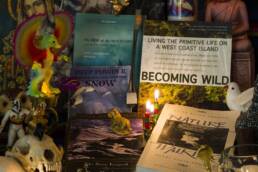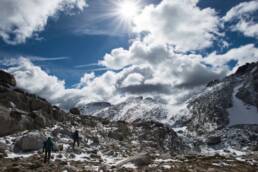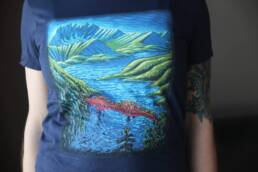The Quran, Torah, Bhagavad Gita and the Bible: they’re all scripture that continues to shape and give meaning to Earth’s civilizations. But to some, “holy” is simply defined as what makes us complete. Each of the following six books details the experiences of those who discover a kind of spiritual wholeness in the wild. Whether finding solitude on a rock face or slipping over an a-ha moment while skiing, many authors fuse inner landscapes with the outside world to explore the old adage of “being one with nature.” From a mid-19th century philosopher out on a forest meander to a young woman who falls asleep beside a purring cougar, these personal quests link people with something greater than themselves. If you’re lucky, at least one of these books will nudge you — or your kids — out the door, tapping into what is holy for you.
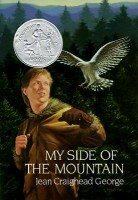 MY SIDE OF THE MOUNTAIN
MY SIDE OF THE MOUNTAIN
AUTHOR: Jean Craighead George
FIRST PUBLISHED: 1959
CURRENT EDITION: Puffin Modern Classics (2004)
[one_half]Since the 1960s, My Side of the Mountain has sparked the wild spirits of countless adventurers-to-be who likely read this by flashlight in their backyard, drooling over foraged puffballs instead of fire-charred marshmallows. For older readers, this book is a reminder to kick off the fossilizing doldrums by loading a backpack with nothing but curiosity before heading into the hills.
A timeless tale of young independence, the book is dedicated “to the bit of Sam Gribley in the children and adults around me now,” writes author Jean Craighead George.[/one_half][one_half] Gribley is a fictional 12-year-old boy who trades his life in the city for an adventure in the Catskill Mountains of upstate New York. He runs away with some flint and steel, plus “a penknife, a ball of cord, an ax and $40.”
Gribley is a rugged little gaffer who turns an old tree stump into his home, befriends a weasel, trains a falcon to catch rabbits for breakfast, and then sews himself a deer-skin suit. He lives mostly alone and off-the-land through the seasons, surviving and thriving in mountain wilderness in a way most of us only fantasized about as kids.[/one_half]
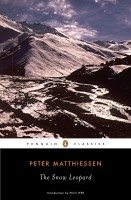 THE SNOW LEOPARD
THE SNOW LEOPARD
AUTHOR: Peter Matthiessen
FIRST PUBLISHED: 1978 / Viking Press
CURRENT EDITION: Penguin Books (2008)
[one_half]“There is much that enchants me in this spare, silent place that I move softly so as not to break a spell,” writes Peter Matthiessen from his tent near Crystal Mountain in the inner Dolpo Region of Nepal’s Tibetan Plateau. It is early November 1973. After five weeks of hiking through and over treacherous passes, Matthiessen and field biologist George Schaller are set up below the Buddhist monastery Shey Gompa to study the Himalayan blue sheep, hoping to glimpse the elusive snow leopard slinking about the high mountains.[/one_half][one_half]
Winner of the 1979 National Book Award, The Snow Leopard intimately details an expedition Matthiessen describes as being “a journey of the heart” where geographical, spiritual and emotional terrain are navigated and conveyed with evocative precision, diary-style. How many people have set this book down and promptly booked a flight to Nepal? Matthiessen plants seeds of wonder by craftily stitching soulful reflections into his descriptions of the Himalayan landscape. Now considered a classic in the non-fiction nature department, The Snow Leopard will leave you as taut and silent as the cold air it was written in.[/one_half]
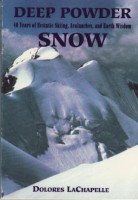 DEEP POWDER SNOW:
DEEP POWDER SNOW:
40 YEARS OF ECSTATIC SKIING, AVALANCHES, AND EARTH WISDOM
AUTHOR: Dolores LaChapelle
FIRST PUBLISHED: 1993
CURRENT EDITION: Kivaki Press (1993)
[one_half]Dolores LaChapelle was not just passionate about skiing. She was passionate about deep powder skiing. In fact, a life of moving — rather, floating — through untracked slopes of deep powder snow is what guided her spiritual path.
In this pint-sized book, LaChapelle describes the full-bodied, non-rational immersion she experienced while skiing powder in Alta, Utah, and how the process of being caught in an avalanche “freed” her from feeling confined to her Catholic beliefs and upbringing.[/one_half][one_half] LaChapelle pursues the metaphor of travelling over unbroken snow to expound on the philosophies of Heidegger, a 20th century philosopher who held seminars while climbing mountains near Freiburg, Germany.
Known as both a skilled mountaineer and a contributor to the Deep Ecology movement, LaChapelle weaves philosophy, skiing history, and personal anecdote together, offering a narrative on how to live in accordance with nature. The result is very much like the lines LaChapelle would have drawn down an untouched slope: rhythmic and fluid, as though in a dance. She passed away in 2006 at 81 years old. This was her fourth and final book. Originally priced at $6.95, a used copy now fetches up to $300 online.[/one_half]
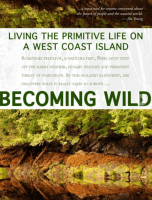 BECOMING WILD
BECOMING WILD
AUTHOR: Nikki Van Schyndel
FIRST PUBLISHED: 2014
CURRENT EDITION: Caitlin Press (2014)
[one_half]Who was Nikki Van Schyndel’s childhood hero? Sam Gribley, of course (see My Side of the Mountain on previous page). Twenty years later, Van Schyndel and Micah Fey — a friend she had recently met at a wilderness survival camp — were dropped off on a remote island on the central coast of British Columbia where for 555 days they put their survival skills into practice.
In Becoming Wild, the author intertwines ancient survival tips with “holy-shiza” anecdotes that make your hands seem city-soft and your guts a bit jumpy. The friends and Van Schyndel’s cat Scout were completely embedded in coastal wilderness, blurring the human-nature divide.[/one_half][one_half] They nibbled on stick-roasted mice and sautéed squirrels to fend off hunger, were kept awake by banshee-like screams of a grouchy cougar, and carved halibut hooks out of bear bones. Except for the fact that Van Schyndel tried to keep a coat of magenta nail polish on her toes for the duration of their adventure, they became a set of real-life Gribley twins.
The book also has a spiritual element as Van Schyndel reflects on the inter-reliance between herself and the natural world. “I didn’t find religion in the Bible” she writes. “I found a truth that resonated with my soul.”[/one_half]
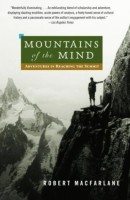 MOUNTAINS OF THE MIND
MOUNTAINS OF THE MIND
AUTHOR: Robert MacFarlane
FIRST PUBLISHED: 2003
CURRENT EDITION: Vintage (2004)
[one_half]Photos from early Everest expeditions show frostbitten toes, sun-charred faces, and zany grins on a summit. For many, these quasi-grim scenes translate into something raw yet magical. In his award-winning non-fiction book Mountains of the Mind, MacFarlane delves into the cultural fascination and romanticism that is tied to mountain exploration. What compels us to ditch home comforts, stripping ourselves of safety to shinny up and over ice? How have perceptions of mountains shifted and been shaped over the last three centuries?[/one_half][one_half] Digging through cultural references, MacFarlane explores these questions, interspersing his own climbing experiences with gathered history.
“What we call a mountain,” he writes, “is thus in fact a collaboration of the physical forms of the world with the imagination of humans — a mountain of the mind.” Although occasionally critiqued for being too Euro-focused, MacFarlane poetically pieces together the ideas, emotions and metaphors that have culminated in a collective desire to stand on and amidst rocky spires.[/one_half]
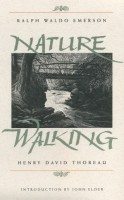 NATURE / WALKING
NATURE / WALKING
AUTHOR: Ralph Waldo Emerson / Henry David Thoreau
FIRST PUBLISHED: 1836 / 1862
CURRENT EDITION: Beacon Press (1994)
[one_half]The essay “Nature” by Emerson and “Walking” by Thoreau are bound between the covers of this book, conveniently placing two of America’s most influential nature writers side by side.
Published anonymously in 1836, “Nature” is considered one of Emerson’s earliest manifestos for transcendentalism, a religious, philosophical and literary movement that sought a deeper relationship with the physical universe. Thoreau’s “Walking” came almost 30 years later. An advocate for spending at least four hours a day “sauntering through woods and over the hill and fields, absolutely free from all worldly engagements,” Thoreau details how the act of walking in the wilds can spur on a spiritual connection with nature, providing metaphysical guidance that conformed thinking lacks.[/one_half][one_half] He chides his fellow village folk for being too tied to their daily lives, immersed in gossip and chitchat instead of meandering free through the thickets and bogs beyond town.
A century and a half has passed since the essay was first published and still it resonates in a way that is both light and dark. “In Wildness is the preservation of the World,” writes Thoreau.[/one_half]
Mitchell Scott
Mitchell Scott is the Editor-in-Chief and co-publisher of Kootenay Mountain Culture Magazine.
Related Stories
Framed in Leavenworth With Coast Mountain Culture
This past weekend, CMC was on hand to sponsor and participate in Leavenworth's Framed Photographer Invitational, where…
Coast Mountain Culture Launches Premiere Issue
You may have seen a copy of the new Coast Mountain Culture Magazine (CMC) floating through outdoor veins throughout…
New Summer Issue of Coast Mountain Culture Days Away
It's at the printer getting printed, and we can't wait to drop our first ever summer edition, the Versus Issue. Stay…
The Gathering at Red Mountain
This upcoming Easter weekend RED and POWDER Magazine are presenting the 2nd annual Gathering at RED. Come hang with…
Our New Store – Kootenay Mountain Culture + Coast Mountain Culture
We got tired of people asking for the shirts off our backs and the hats of our noggins. So we opened an online store.…


